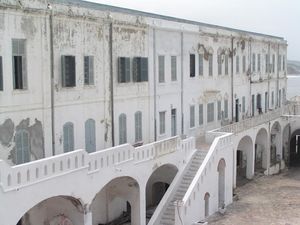Catherine Quaque
Catherine Quaque (née Blunt) was one of the first white women who travelled to the Gold Coast (today: Ghana).
Life in England
Catherine Blunt was born in England in the 18th century. She was member of the Anglican Church, was able to read and write and was trained in Christian doctrine. She met a man called Philipp Quaque who came from the Gold Coast. Reverend Thomas Thompson had educated him and invited him to England for further education. The bishop of London ordained Quaque a priest in April 1765. In May 1765, he married Catherine Blunt.
The Society of the Propagation of the Gospel sent Quaque back to the Gold Coast in order to continue reverend Thompson’s mission.
Journey to the Gold Coast
The young couple travelled to the Gold Coast, where they arrived in February 1766. Catherine was accompanied by a female servant.
The Gold Coast was infamous for the tropical diseases and was called “The white man’s grave”. The most dangerous diseases were yellow fever and malaria. When the couple arrived, the worst season was approaching with tropical heat and high humidity.
The journey at that time lasted at least six weeks and was a heavy burden. The landing was complicated. Because of the rocks all along the shore, the ships had to stay far away from the coast line. Small boats of very simple construction transported the passengers, who had to climb down from the ship into the boats or were lifted down. This act was dangerous because of the rough see.
Life on the Gold Coast
The Quaques were living in two rooms in Cape Coast Castle. The building was the administration centre of Gold Coast and the governor’s seat. The governor lived in the first floor of the castle. The ground floor was populated by soldiers, civil servants and others. The basement contained mainly slave dungeons.
Quaque opened a school and tried to propagate Christianity. The population did not accept him because he was alienated and had married a white lady. The mission made sluggish process.
The conditions must have been oppressive for Catherine. A white lady in a crinoline, exposed to the almost unbearable climate, living in a castle in which slaves were suffering.
Death
Six or seven months after her arrival, Catherine died. Her husband wrote about a loss due to “these sullen and cruel climates”. The couple had no children.
Two years after her death, Philipp Quaque married the female servant who had accompanied his first wife. After the death of his second wife in 1772, he married an indigenous woman. He never had much success in his mission and died at the age of 75.
Sources
- Papers of Philip Quaque - Collection 151 [1]
Literature
- Amissah, G. McLean, Cape Coast in Historical Perspective, 1994
- Bartels, F. L., Phillip Quaque 1741-1816 Tr Hist Soc Gh Vol 1 154
- Debrunner, Hans W., A History of Christianity in Ghana, Accra 1967
- Lee, Mrs. R. (Mrs. T. Edward Bowdich), Stories of Strange Lands, London, 1835
- Reese, Ty M. The Trials and Tribulations of Philip Quaque, 1741-1816 An African Missionary in West Africa
- Reese, Ty M., 'Sheep in the Jaws of So Many Ravenous Wolves': the Slave Trade and Anglican Missionary Activity at Cape Coast Castle, 1752-1816 Journal of Religion in Africa, Volume 34, Number 3 / September 2004, p. 348-372

